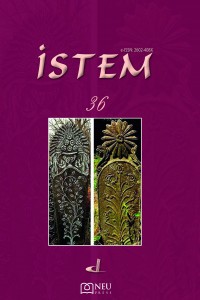Öz
Cemil Bey, Türk mûsikîsi tarihinde Tanbûr icrâsıyla öne çıkmış, tanbur yanında Klâsik Kemençe, Lavta, Yaylı Tanbur, viyolonsel gibi sazlarda yaptığı icralarıyla ekol olmuş, Türk mûsikîsinin özellikle Saz Mûsikîsi başlığı altında eşsiz eserler vücuda getirmiş çok önemli bir icracıdır. Cemil Bey aynı zamanda Türk mûsikîsi nazariyatı alanına da Rehber-i Mûsikî adında bir eser bırakmıştır. Türk mûsikîsinde nazariyat ve icra arasındaki benzer ve farklılıklar pek çok araştırmaya konu olmuştur. Türk mûsikîsinin temel nazariyat kaynakları olan bestelenmiş ve günümüze intikâl edebilmiş eserler ve usta icracıların ses kayıtlarının tahlil edilmesi suretiyle, mûsikîmizin makam yapısı ve zenginliği daha derin kavranabilmektedir. Bu çalışmada, Cemil Bey’in viyolonsel ile yapmış olduğu Hüseynî makamındaki taksimi, müellifi olduğu Rehber-i Mûsikî’deki makam anlatımı temelinde irdelenmiştir. Böylece Cemil Bey’in nazariyat yaklaşımı ve icrası arasındaki benzerlik ve farklılıklar makam tahlilleriyle somutlaştırılmaya çalışılmıştır. Çalışmanın sonucunda Türk mûsikîsi makamlarının kavranması konusunda icrânın öneminin altı çizilmiş, bu ve buna benzer çalışmaların, mûsikîmizin eğitim-öğretim alanına materyal olarak kazandırılması önerilmiştir.
Anahtar Kelimeler
Kaynakça
- Aksoy, Bülent. Avrupalı Gezginlerin Gözüyle Osmanlılarda Musiki. İstanbul: Pan Yayınları, 1. Basım, 2000.
- Aydemir, Murat. “Tamburi Cemil Bey’in Etkilerine Dair’’. Yüzyıllık Metinlerle Tanburi Cemil Bey. ed. Hüseyin Kıyak. 364. İstanbul: 2017.
- Cemil, Mesut. Tamburi Cemil’in Hayatı. nşr. Uğur Derman. 1 Cilt. İstanbul: Kubbealtı Neşriyat, 4. Basım, 2016.
- Cevher, M. Hakan. Tanburi Cemil Bey ve Rehber-i Mûsikî. İzmir: Ege Üniversitesi, Sosyal Bilimleri Enstitüsü, Yüksek Lisans Tezi, 1992.
- Gönül, Mehmet. Nevres Bey’in Ud Taksimlerinin Analizi Ve Ud Eğitimine Yönelik Alıştırmaların Oluşturulması. Konya: Selçuk Üniversitesi, Eğitim Bilimleri Enstitüsü, Doktora Tezi, 2010.
- Özalp, Mehmet, Nazmi. Türk Mûsikîsi Tarihi. 1 Cilt. İstanbul: MEB Yayınları, 1. Basım, 2000.
- Öztuna, Yılmaz. Türk musikisi Ansiklopedisi. İstanbul: Milli Eğitim Basımevi, 1.Basım, 1969.
- Öztürk, Y. Özgen - Beşiroğlu, Ş. Şehvar. “Viyolonselin Türk Makam Müziğine Girişi Ve Tanburi Cemil Bey’’. İtü Sosyal Bilimler Dergisi 6/1 (Aralık 2009), 31-40.
- Yahya, Kaçar, Gülçin. Türk Mûsikîsi Üzerine Görüşler (Analiz ve Yorumlar). Ankara: Maya Akademi Yayım Dağıtım Eğitim Danışmanlık, 2. Basım, 2009.
Öz
Cemil Bey came to the fore with his performance of Tanbur in Turkish music history, became a school with his performances on instruments such as Classical Kemençe, Lavta, Yaylı Tanbur, and Violoncello besides the tanbur, and he is a very important performer who has composed unique works of Turkish music, especially under the title of Turkish Instrumental Music. Cemil Bey also left a Book called Rehber-i Mûsikî in the field of Turkish music theory. The similarities and differences between theory and performance in Turkish music have been the subject of many studies. By analyzing the music, which are the basic theoretical resources of Turkish music, the works that have survived to the present day and the sound recordings of master performers, the structure and richness of our music can be understood more deeply. In this study, Cemil Bey's taksim in Huseyni makam, which he made with the violoncello, was examined on the basis of the makam expression in Rehber-i Mûsikî that he was the author of. Thus, the similarities and differences between Cemil Bey's theoretical approach and execution were tried to be concretized with makam analysis. As a result of the study, the importance of performance in understanding Turkish music makams was underlined, and it was suggested that these and similar studies be introduced to the field of education of our music.
Anahtar Kelimeler
Kaynakça
- Aksoy, Bülent. Avrupalı Gezginlerin Gözüyle Osmanlılarda Musiki. İstanbul: Pan Yayınları, 1. Basım, 2000.
- Aydemir, Murat. “Tamburi Cemil Bey’in Etkilerine Dair’’. Yüzyıllık Metinlerle Tanburi Cemil Bey. ed. Hüseyin Kıyak. 364. İstanbul: 2017.
- Cemil, Mesut. Tamburi Cemil’in Hayatı. nşr. Uğur Derman. 1 Cilt. İstanbul: Kubbealtı Neşriyat, 4. Basım, 2016.
- Cevher, M. Hakan. Tanburi Cemil Bey ve Rehber-i Mûsikî. İzmir: Ege Üniversitesi, Sosyal Bilimleri Enstitüsü, Yüksek Lisans Tezi, 1992.
- Gönül, Mehmet. Nevres Bey’in Ud Taksimlerinin Analizi Ve Ud Eğitimine Yönelik Alıştırmaların Oluşturulması. Konya: Selçuk Üniversitesi, Eğitim Bilimleri Enstitüsü, Doktora Tezi, 2010.
- Özalp, Mehmet, Nazmi. Türk Mûsikîsi Tarihi. 1 Cilt. İstanbul: MEB Yayınları, 1. Basım, 2000.
- Öztuna, Yılmaz. Türk musikisi Ansiklopedisi. İstanbul: Milli Eğitim Basımevi, 1.Basım, 1969.
- Öztürk, Y. Özgen - Beşiroğlu, Ş. Şehvar. “Viyolonselin Türk Makam Müziğine Girişi Ve Tanburi Cemil Bey’’. İtü Sosyal Bilimler Dergisi 6/1 (Aralık 2009), 31-40.
- Yahya, Kaçar, Gülçin. Türk Mûsikîsi Üzerine Görüşler (Analiz ve Yorumlar). Ankara: Maya Akademi Yayım Dağıtım Eğitim Danışmanlık, 2. Basım, 2009.
Ayrıntılar
| Birincil Dil | Türkçe |
|---|---|
| Bölüm | Araştırma Makaleleri |
| Yazarlar | |
| Yayımlanma Tarihi | 31 Aralık 2020 |
| Gönderilme Tarihi | 27 Ekim 2020 |
| Yayımlandığı Sayı | Yıl 2020 Sayı: 36 |

